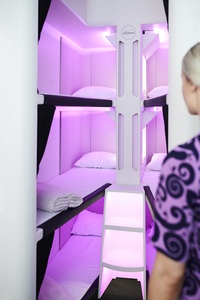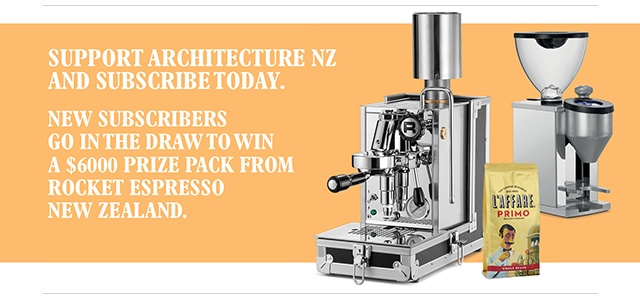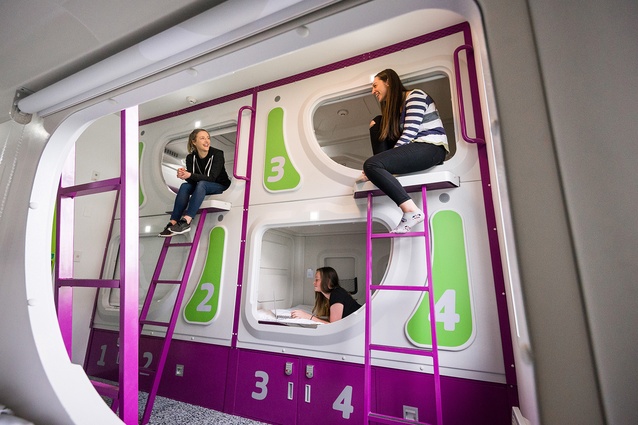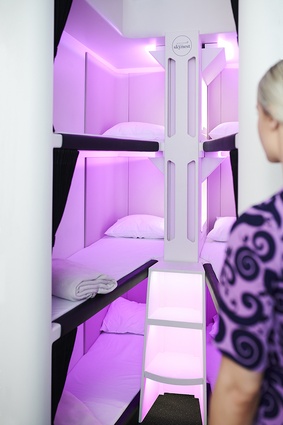Peace in a pod
Julia Gessler explores how sleeping pods are becoming a growing trend both on and off the ground.
[Editor’s note: This article was produced for print publication in March 2020 before the COVID-19 lockdown measures went into effect. The tourism industry has and will continue to change drastically due to the closure of international borders around the world. As such, parts of this article may not reflect very recent changes to an ever-evolving hotel sector, but provide a valuable snapshot of earlier trends.]
Kisho Kurokawa’s Nakagin Capsule Tower was, in Tokyo’s Shimbashi area in 1972, an uncompromising metabolist feat. Today, the office and residential project’s impressive stature is overshadowed by its sheer state of disrepair, looking, at a distance, like a long-abandoned game of Jenga. Rooms protrude out, damage permeates in. Yet the very nature of its design – a woven set of tiny, port-hole-like containers for living – warrants being mentioned in the wake of a global surge of small, high-density lodgings (be they permanent or nomadic).
What Kurokawa’s masterpiece once shared with its present-day progeny was a futuristic aesthetic that felt at once of and beyond its times. In New Zealand, pod hotel chain Jucy Snooze, which entered the market in 2016, has achieved this with its bunk-bed-like capsules; marked in Jucy’s signature colour palette of lime green and purple, they look clean, ergonomic, even streamlined.

“Fitted around steel frames, non-flammable ABS plastic was chosen for the Jucy Snooze Christchurch and Queenstown pods because of its fire safety and cleanability,” explains Jucy co-founder Dan Alpe. Conversely, for its new Auckland site, the pods will “be fronted by a more-natural wooden face panel that can be removed if damaged and that aligns with a more-sustainable and eco-friendly development where possible”.
With plans to expand nationally and internationally following a joint venture agreement with Event, one of Australasia’s hospitality behemoths, Jucy Snooze’s key design considerations, from “flexibility of privacy” to “connectivity”, “comfort”, “security” and, now, the environment, have helped secure its place in the capsule market.
Air New Zealand has taken a similar kind of thinking above ground. The airline recently announced its first lie-flat prototype, called the Economy Skynest, which will allow Economy passengers the opportunity to sleep in one of six sleep pods. Made with the airline’s more-than-17-hour Auckland–New York long hauls in mind, the sleeping system has “overcome a number of difficulties, including the regulations we must comply with on board our aircraft and safety for customers, coupled with making it feel comfortable, look good and work from a crew perspective,” posted Kerry Reeves, Head of Aircraft Programmes for Air New Zealand.
In the end, these challenges were little obstacles. “We have the permission to be bold, push boundaries and try new things to challenge the aviation industry,” explained Reeves. “The question is never ‘can we do this?’ but, instead, ‘is it right to do this for our customers?’ and, if so, ‘how will we do this?’ Skynest is a tangible example of us doing just that.”
Where Kurokawa failed to account fully for Nakagin Capsule Tower’s future (its capsules, intended to be replaced every 20 years, were never changed), Jucy Snooze and Air New Zealand appear to be taking careful, plausible-seeming measures to ensure the longevity of their highly practical snooze thrones.












